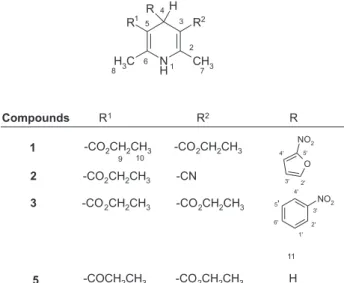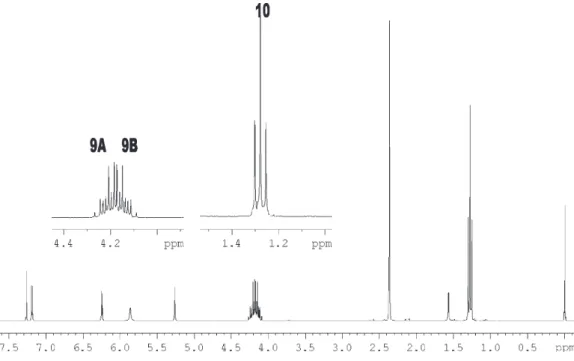J. Braz. Chem. Soc., Vol. 16, No. 1, 112-115, 2005. Printed in Brazil - ©2005 Sociedade Brasileira de Química 0103 - 5053 $6.00+0.00
S
ho
rt
R
e
p
o
rt
* e-mail: jacar@ciq.uchile.cl
Unexpected Diastereotopic Behaviour in the
1H NMR Spectrum of 1,4-Dihydropyridine
Derivatives Triggered by Chiral and Prochiral Centres
Jacqueline Argüello DaSilva*,a, Claudio Saitz Barríab, Carolina Jullianb, Patricio Navarreteb,
Luis Núñez Vergaraa and Juan A. Squellaa
a
Laboratorio de Bioelectroquímica and bDepartamento de Química Orgánica y Físico Química, Facultad de Ciencias Químicas y Farmacéuticas, Universidad de Chile, PO Box 233, Santiago, Chile
Derivados de 1,4-dihidropiridina constituem um importante grupo farmacológico para o tratamento de doenças cardiovasculares. Sintetizamos neste trabalho uma série de 4-(5'-nitro-2'-furil)-1,4-dihidropiridina derivados, os quais foram caracterizados por 1H RMN. Observamos que grupos
carboxílicos em C-3 e C-5 no anel 1,4-dihidropiridine mostram um sinal muito mais complexo no espectro de 1H RMN, tanto quando C-4 é um centro quiral ou pseudo-quiral.
1,4-dihydropyridine derivatives constitute an important pharmacological group for the treatment of cardiovascular diseases. We have synthesised a series 4-(5'-nitro-2'-furyl)-1,4-dihydropyridine derivatives, which were characterised by 1H-NMR. We have found that carboethoxy groups at the
C-3 and C-5 on the 1,4-dihydropyridine ring show a much more complex signal in the 1H NMR
spectra, either when C-4 is a pseudo-prochiral or a chiral centre.
Keywords: NMR, 1H NMR, 1,4-dihydropyridines, carboethoxy group, enantiotopic methylene
hydrogens
Introduction
1,4-dihydropyridine derivatives (DHPs) of the nifedipine compound type, are potential antihypertensive drugs based on their Ca+2-channel antagonistic activity.
The precise mode of interaction is believed to involve the insertion into a binding site of the alpha 1 subunit of the L-type voltage gated channels present in skeletal and cardiac muscle.1
The presence of ester groups, at the 3 and 5 positions on the 1,4-dihydropyridine ring, is of crucial importance for the pharmacological effects. It has been suggested that these groups produce hydrogen bonding with the receptor site. 2
Attempts to find improved bioavailability, longer duration of therapeutic action and other pharmacological applications, have encourage the synthesis of many structural analogues of nifedipine. Furthermore, in a previous work we have reported that some 1,4-DHPs inhibit the oxygen consumption by T. cruzi epimastigotes, Tulahuén strain.3
In this scope, recently, we have synthesized some 4-(2'-furyl-5'-nitro)-1,4-DHP derivatives, compounds 1-2.
In the 1H NMR spectrum of the mentioned compounds, a
very interesting feature was observed; the signal arising from the methylene group of the carboethoxy substituent does not appear as a simple quartet in disagreement with several previous reports.4-7 The spectrum shows a more
complex splitting pattern. Although several 1HNMR
spectral values have been reported, they contain insufficient data.8-10
Herein, we communicate the undescribed observation of non-equivalence for the two hydrogens of the carboethoxy methylene group in compounds of the dihydropyridine’s type (1-4 Figure 1). In addition, the full
1H NMR data of these compounds is reported.
Results and Discussion
The labelling system used for the hydrogens of 1-5 is shown in the structural formula (Figure 1). Chemical shifts and coupling constants for 1-5 are summarized in Table 1.
The 1H NMR spectrum corresponding to the methylene
113 Unexpected Diastereotopic Behaviour in the 1H NMR Spectrum
Vol. 16, No. 1, 2005
observed (Jgem 10.91 Hz) equally split by the neighbor hydrogens (Jvic 7.10 Hz) for the compound 1. Thus, the non-equivalent hydrogens of the CH2 (H-9A and H-9B) are split into a doublet, and each peak of the doublet is split into a quartet. The methyl hydrogens are split into a doublet, and each peak of the doublet into another doublet with equal or very similar coupling constants (H-10). The
spectrum belongs to the three-spin ABX3 type. This
observation has been confirmed by the simulation of the system11 (Figure 3).
Continuing with our efforts to find similar splitting
patterns in other compounds of the series, we synthesized the compounds 3 and 4, and a similar effect has been observed. This behavior arises because C-4 is a prochiral center in compounds 1, 3 and 4 (although, actually it should be described as a “pseudo-prochiral” center because the R1 and R2 ligands, which would make it a prochiral
center, are part of the ring and cannot be separately removed as required in the test for prochirality) and an
asymmetric center in compound 2. The methylene
hydrogens of the carboethoxy group in these compounds are diasterotopic and they are five bonds from the pseudo-prochiral or chiral center.12,13 Prochiral groups (including
hydrogens) are intrinsically non-equivalent by the chemical shift criterion (i.e., diasterotopic) when there is not a symmetry plane, s, bisecting the R1-C-R2 angle. If
geminal hydrogens (CH2) in a molecule cannot be
interchanged through a symmetry element, those hydrogens are diastereotopic to one another; then each has a different chemical shift, except for coincidental overlap. The occurrence of diastereotopic methylene hydrogens has been observed in some achiral compounds, such as: citric acid, glycerol, diethyl acetal, 3-hidroxiglutaric acid. In these molecules the chemical shift nonequivalence effect has been measured through two and three bonds between the chiral center and the methylene hydrogens. Although, the methylene groups in the 1,4-dihydropyridine derivatives are not chemical shift equivalent even the hydrogens are five bonds removed from the chiral or prochiral center.14,15
Table 1. 1 H NMR chemical shifts (ppm) and coupling constants (Hz) of dihydropyridines 1- 5
hydrogens 1 2 3 4 5
H-1 6.19 brs 6.04 brs 5.74 brs 5.57 brs 5.17 brs
H-4 5.27 s 4.90 s 5.09 s 3.83 q 3.27 s
(3J 11 6.43)
H-7 2.36 s 2.38 s 2.37 s 2.27 s 2.19 s
H-8 2.36 s 2.18 s 2.37 s 2.27 s 2.19 s
H-9A 4.15 dq 4.12 dq 4.07 dq 4.16 dq 4.17 q
(3J 10 7.10,
2J
9B -10.91) ( 3J
10 7.10, 2J
9B -10.9) ( 3J
10 7.10, 2 J
9B -10.8) ( 3J
10 7.02, 2J
9B -11.0) ( 3J
10 7.09)
H-9B 4.21 dq 4.16 dq 4.11 dq 4.22 dq 4.17 dq
(3J 10 7.10,
2J
9A -10.91) ( 3J
10 7.10, 2J
9A-10.9) ( 3J
10 7.15, 2J
9A10.8) ( 3J
10 7.02 2J
9A-11.0) (
3J 10 7.09)
H-10 1.28 dd 1.29 dd 1.29 dd 1.30 dd 1.29 t
(3J 9A
3J
9B 7.10) ( 3J
9A 7.10, 3J
9B 7.15) ( 3J
9A 7.10 3J
9B 7.15) ( 3J
9A 3J
9B 7.02) (
3J 9 7.09)
H-11 — — — 0.97 d —
H-2’ — — 8.13 dd — —
(4J 4’ 2.29,
4J 6’ 1.75)
II-3’ 6.26 d 6.38 d — — —
(3J
4’ 3.44) (
3J 4’ 3.7)
H-4’ 7.21 d 7.24 d 8.00 ddd — —
(3J
3’ 3.44) (
3J
3’ 3.7) ( 4J
2’ 2.29, 3J
S’ 8.2( 4J
6’ 1.18)
H-5’ — — 7.37 dd — —
(3J 4’ 8.2,
3J 6’ 7.65)
H-6’ — — 7.64 ddd — —
(4J 2’1.75,
4J 4’ 1.18,
3J 5’ 7.65)
114 Argüello-DaSilva et al. J. Braz. Chem. Soc.
To confirm the influence of the chirality on the splitting pattern in the studied compounds, we synthesized the non substituted compound 5, where the C-4 is a C2 center, therefore, these hydrogens are enantiotopic and, consequently, the corresponding spectrum of this compound showed the methylene group signal as a simple quartet.
Also, we have found that commercially available DHPs, nitrendipine, nisoldipine, isradipine exhibit a complex splitting pattern in their 1H NMR spectra. In the first case,
due to a non-equivalence of the two hydrogens of the carboethoxy methylene group and due to a non-equivalence of the two methyl groups of the isopropoxy moiety in the other two cases.
In conclusion, we have found that the pseudo-prochiral C-4 on the 1,4-dihydropyridine ring, (compound 1, 3 and
4) and the chiral center (compound 2), are responsible on the splitting pattern. The two methylene hydrogens are diastereotopic and they give an ABX3 spin system.
Experimental
The compounds 1-5 were synthesised by a modified method from the Hantzsch synthesis.16 Nitrendipine,
nisoldipine, isradipine were obtained from Sanitas Laboratories, Chile Laboratories and Sandoz Laboratories, respectively.
Hydrogen NMR spectra were acquired using a Bruker Figure 2. 1 H NMR spectrum of the compound 1.
115 Unexpected Diastereotopic Behaviour in the 1H NMR Spectrum
Vol. 16, No. 1, 2005
AVANCE DRX 300 spectrometer operating at a hydrogen frequency of 300.13 MHz. Acquisition and data treatment were carried out with XWIN-NMR 3.0 Bruker program. All measurements were performed at a probe temperature of 300ºK, using solutions of compounds 1-5 in CDCl3 containing tetramethylsilane (TMS) as an internal standard.
1H spectra were obtained with a spectral width of 4500 Hz,
a 90º flip angle (11 ms) and 1s relaxation delay in 16 scans. An exponential function with Lb = 0.3 Hz was applied before Fourier transformation to enhance the spectral resolution. The number of data points employed was 16384 and the digital resolution was 0.261281 Hz.
The hydrogen spectrum was simulated using Win-Daisy version 4.05 Bruker Program. The system was simulated as an ABX3 group. To perform the spectrum simulation the following main parameters were considered: number of spins or groups with magnetically equivalent nuclei: 3; number of spins to use: 5 (all hydrogens that give rise to signals in the spectrum). The C3 methyl-group was treated with the Composite Particle theory as one particle, so no point group symmetry was present. Three resonance frequency values were considered, two non-equivalent methylene hydrogens and the methyl group. The line width used was 1.4 Hz. Finally, the values for geminal and vicinal coupling constants introduced to simulate the spin system were 10.91 and 7.10 Hz, respectively.
Acknowledgments
We thank FONDECYT (project number 8000016) and Scholarship DAAD = Deustcher Akademischer Austausch Dients.
References
1. Caignan, G.A.; Holt, E.M.; Z. Kristallogr. 2000, 215, 122. 2. Goldmann, S.; Stolteferss, J. ; Angew. Chem. Int. Ed. Engl.
1991, 30,1559.
3. Núñez-Vergara, L.J.; Ortíz, M.E.; Bollo, S. ; Squella, J.A.;
Chem. Biol. Inter. 1997, 106, 1.
4. Torchy, S.; Cordonnier, G.; Barbry, D.; Vanden Eynde, J.J.;
Molecules2002, 7, 528.
5. Yadav, S.J.; Reddy, B.V.S.; Synthetic Commun. 2001, 31, 425. 6. Ilavsky, D. ; Milata, V.; Collet. Czech. Chem. Commun.1996,
61,1233.
7. Anniyappan, M.; Muralidharan, D. ; Perumal, P.T.; Synthetic Commun.2002, 32, 659.
8. Natale, N.R.; Rogers, M.E.; Staples, R.; Triggle,D.J.; Rutledge, A.; J.Med. Chem.1999, 42, 3087.
9. Zamponi, G.W.; Stotz, S.C.; Staples, R.J.; Andro, T.M., Nelson, J.K.; Hulubei,V.; Blumenfeld, A.; Natale, N.R.; J. Med. Chem. 2003, 46, 87.
10. Hadizadeh, F.; Preprint.chemweb.com. 7 October 2001/ 05:58:37 .
11.Win-Daisy Manual, Version 930501, p. 107. 12. Jennings, W. B. ; Chem. Reviews1975, 75, 307.
13. Breitmaier, E.; Structure Elucidation by NMR in Organic
Chemistry. A Practical Guide, J. Wiley & Sons: England, 2002, p. 54.
14. Silverstein, R.M.; Webster, F. X.; Spectrometric Identification of Organic Compounds, J. Wiley & Sons: New York, 1998, p. 171.
15. Friebolin, H.; Basic One-and Two Dimensional NMR
Spectroscopy; VCH Publishers: New York, 1991, p. 344. 16. Hafiz A., I.S.; Darwish, E.S. ; Mahmoud, F.F.; J. Chem.
Research, S1999, 536.
Received: January 7, 2004

